A Comprehensive Report on Performance Metrics for Business Growth
VerifiedAdded on 2020/05/11
|7
|1476
|83
Report
AI Summary
This report delves into the critical role of performance metrics in business development. It identifies key factors for selecting performance metrics, emphasizing the importance of quantifiable drivers linked to business success. The report explains how project reporting needs are defined and highlights the significance of stakeholder involvement in project monitoring. It differentiates between well-defined and poorly defined metrics, exploring their respective signs and cause-and-effect relationships. Recommendations are provided for establishing a robust reporting approach, including clearly defined goals and timely feedback. The report concludes by underscoring the necessity of measuring project success through on-time delivery, quality, and cost variance, providing a comprehensive overview of performance metrics for business growth.

A Right Set of Performance Metrics
Report
Report
Paraphrase This Document
Need a fresh take? Get an instant paraphrase of this document with our AI Paraphraser
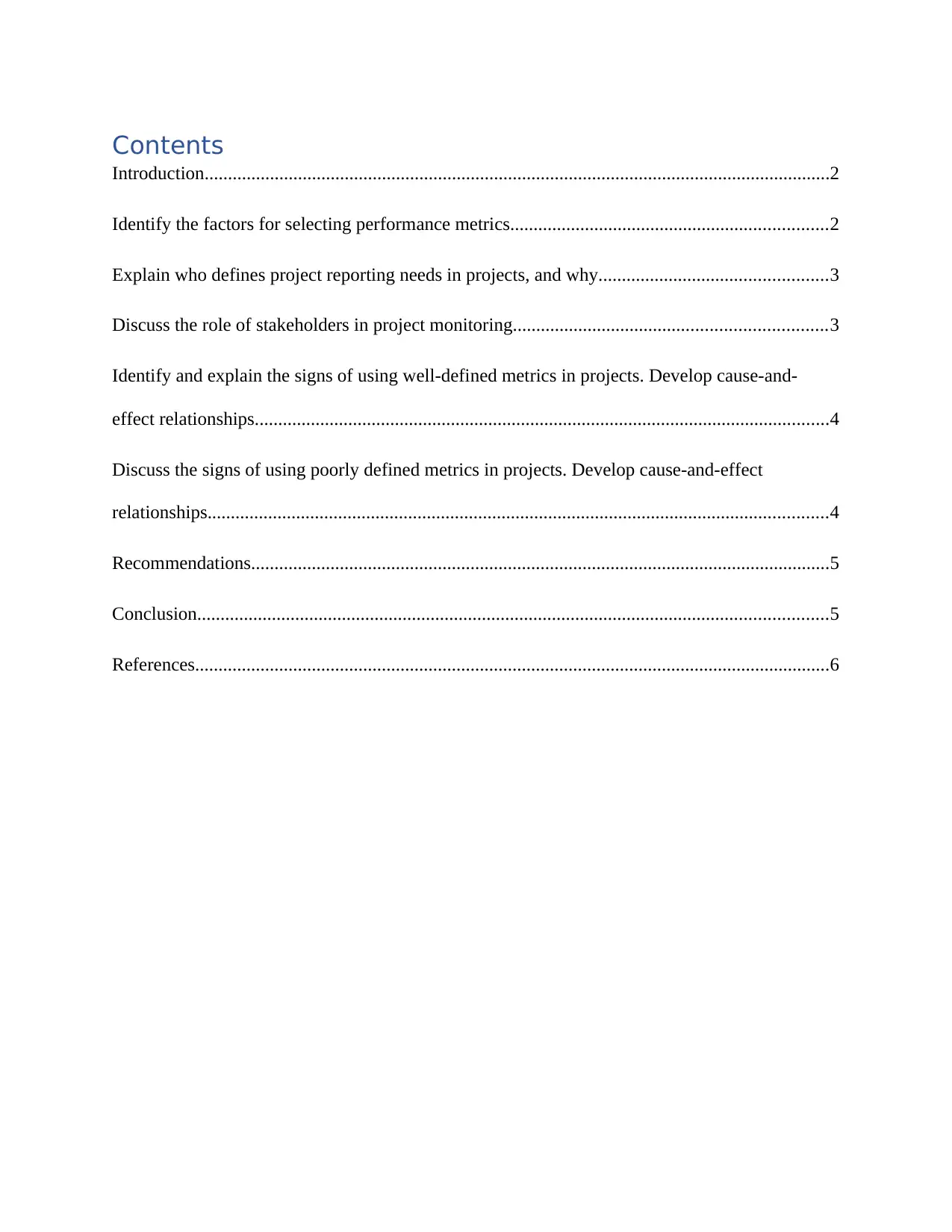
Contents
Introduction......................................................................................................................................2
Identify the factors for selecting performance metrics....................................................................2
Explain who defines project reporting needs in projects, and why.................................................3
Discuss the role of stakeholders in project monitoring...................................................................3
Identify and explain the signs of using well-defined metrics in projects. Develop cause-and-
effect relationships...........................................................................................................................4
Discuss the signs of using poorly defined metrics in projects. Develop cause-and-effect
relationships.....................................................................................................................................4
Recommendations............................................................................................................................5
Conclusion.......................................................................................................................................5
References........................................................................................................................................6
Introduction......................................................................................................................................2
Identify the factors for selecting performance metrics....................................................................2
Explain who defines project reporting needs in projects, and why.................................................3
Discuss the role of stakeholders in project monitoring...................................................................3
Identify and explain the signs of using well-defined metrics in projects. Develop cause-and-
effect relationships...........................................................................................................................4
Discuss the signs of using poorly defined metrics in projects. Develop cause-and-effect
relationships.....................................................................................................................................4
Recommendations............................................................................................................................5
Conclusion.......................................................................................................................................5
References........................................................................................................................................6
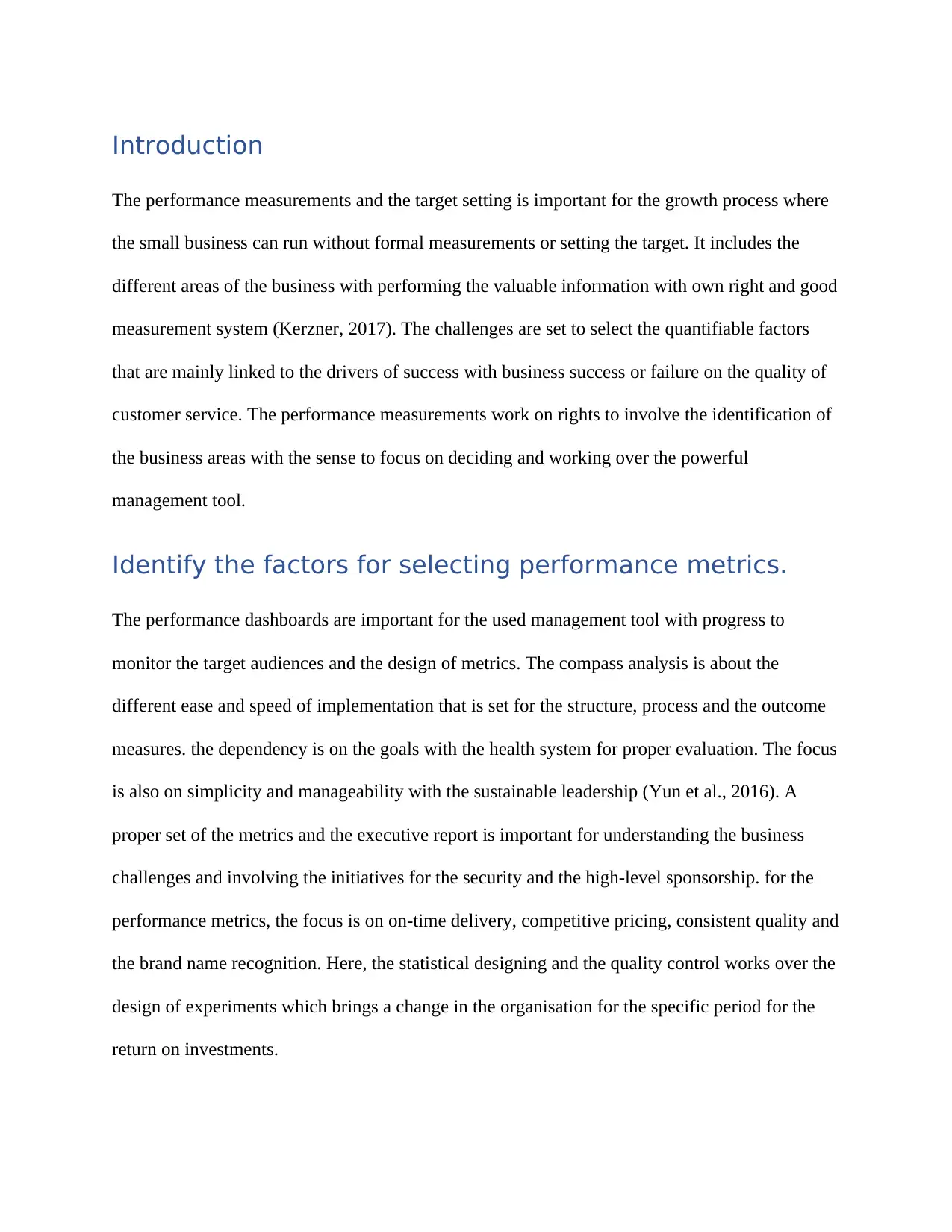
Introduction
The performance measurements and the target setting is important for the growth process where
the small business can run without formal measurements or setting the target. It includes the
different areas of the business with performing the valuable information with own right and good
measurement system (Kerzner, 2017). The challenges are set to select the quantifiable factors
that are mainly linked to the drivers of success with business success or failure on the quality of
customer service. The performance measurements work on rights to involve the identification of
the business areas with the sense to focus on deciding and working over the powerful
management tool.
Identify the factors for selecting performance metrics.
The performance dashboards are important for the used management tool with progress to
monitor the target audiences and the design of metrics. The compass analysis is about the
different ease and speed of implementation that is set for the structure, process and the outcome
measures. the dependency is on the goals with the health system for proper evaluation. The focus
is also on simplicity and manageability with the sustainable leadership (Yun et al., 2016). A
proper set of the metrics and the executive report is important for understanding the business
challenges and involving the initiatives for the security and the high-level sponsorship. for the
performance metrics, the focus is on on-time delivery, competitive pricing, consistent quality and
the brand name recognition. Here, the statistical designing and the quality control works over the
design of experiments which brings a change in the organisation for the specific period for the
return on investments.
The performance measurements and the target setting is important for the growth process where
the small business can run without formal measurements or setting the target. It includes the
different areas of the business with performing the valuable information with own right and good
measurement system (Kerzner, 2017). The challenges are set to select the quantifiable factors
that are mainly linked to the drivers of success with business success or failure on the quality of
customer service. The performance measurements work on rights to involve the identification of
the business areas with the sense to focus on deciding and working over the powerful
management tool.
Identify the factors for selecting performance metrics.
The performance dashboards are important for the used management tool with progress to
monitor the target audiences and the design of metrics. The compass analysis is about the
different ease and speed of implementation that is set for the structure, process and the outcome
measures. the dependency is on the goals with the health system for proper evaluation. The focus
is also on simplicity and manageability with the sustainable leadership (Yun et al., 2016). A
proper set of the metrics and the executive report is important for understanding the business
challenges and involving the initiatives for the security and the high-level sponsorship. for the
performance metrics, the focus is on on-time delivery, competitive pricing, consistent quality and
the brand name recognition. Here, the statistical designing and the quality control works over the
design of experiments which brings a change in the organisation for the specific period for the
return on investments.
⊘ This is a preview!⊘
Do you want full access?
Subscribe today to unlock all pages.

Trusted by 1+ million students worldwide
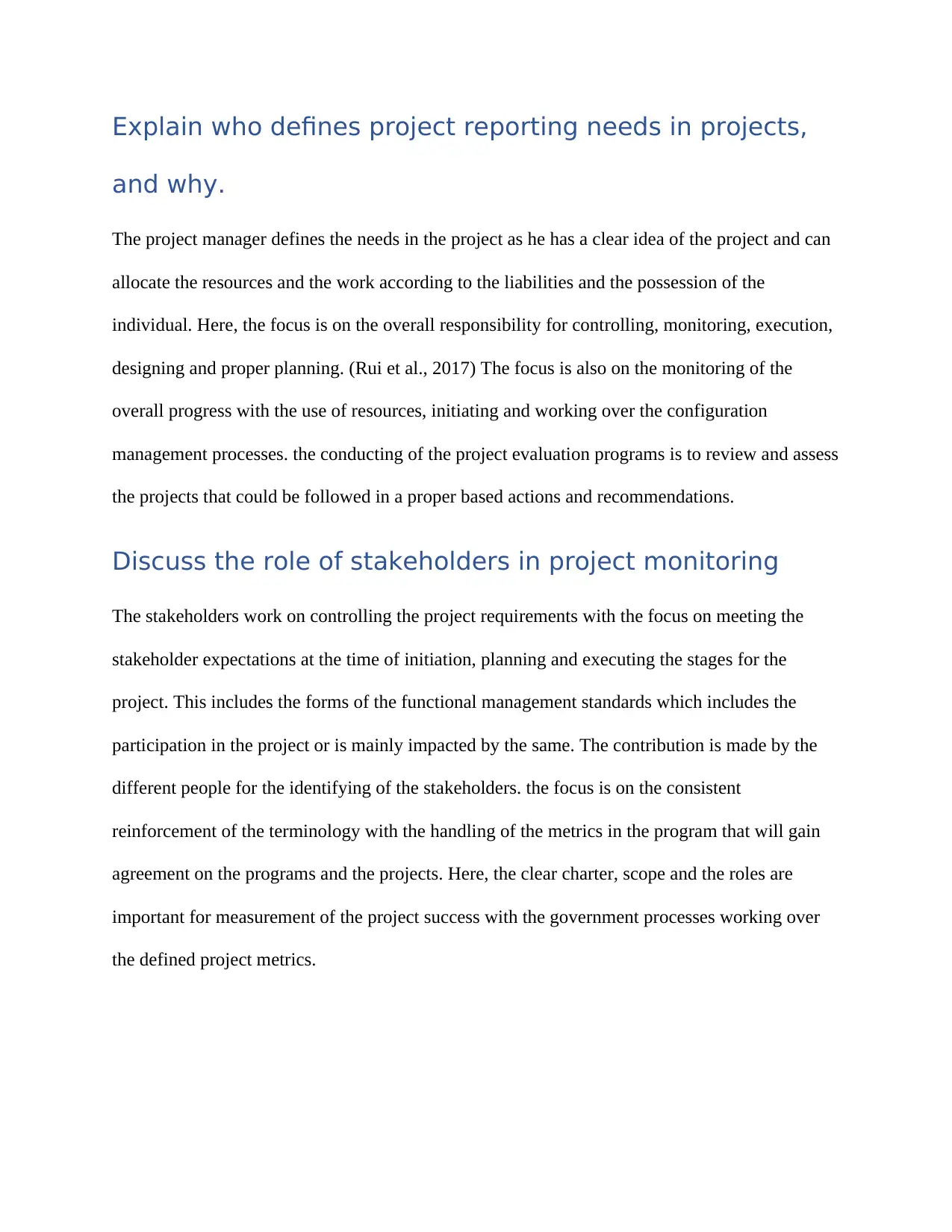
Explain who defines project reporting needs in projects,
and why.
The project manager defines the needs in the project as he has a clear idea of the project and can
allocate the resources and the work according to the liabilities and the possession of the
individual. Here, the focus is on the overall responsibility for controlling, monitoring, execution,
designing and proper planning. (Rui et al., 2017) The focus is also on the monitoring of the
overall progress with the use of resources, initiating and working over the configuration
management processes. the conducting of the project evaluation programs is to review and assess
the projects that could be followed in a proper based actions and recommendations.
Discuss the role of stakeholders in project monitoring
The stakeholders work on controlling the project requirements with the focus on meeting the
stakeholder expectations at the time of initiation, planning and executing the stages for the
project. This includes the forms of the functional management standards which includes the
participation in the project or is mainly impacted by the same. The contribution is made by the
different people for the identifying of the stakeholders. the focus is on the consistent
reinforcement of the terminology with the handling of the metrics in the program that will gain
agreement on the programs and the projects. Here, the clear charter, scope and the roles are
important for measurement of the project success with the government processes working over
the defined project metrics.
and why.
The project manager defines the needs in the project as he has a clear idea of the project and can
allocate the resources and the work according to the liabilities and the possession of the
individual. Here, the focus is on the overall responsibility for controlling, monitoring, execution,
designing and proper planning. (Rui et al., 2017) The focus is also on the monitoring of the
overall progress with the use of resources, initiating and working over the configuration
management processes. the conducting of the project evaluation programs is to review and assess
the projects that could be followed in a proper based actions and recommendations.
Discuss the role of stakeholders in project monitoring
The stakeholders work on controlling the project requirements with the focus on meeting the
stakeholder expectations at the time of initiation, planning and executing the stages for the
project. This includes the forms of the functional management standards which includes the
participation in the project or is mainly impacted by the same. The contribution is made by the
different people for the identifying of the stakeholders. the focus is on the consistent
reinforcement of the terminology with the handling of the metrics in the program that will gain
agreement on the programs and the projects. Here, the clear charter, scope and the roles are
important for measurement of the project success with the government processes working over
the defined project metrics.
Paraphrase This Document
Need a fresh take? Get an instant paraphrase of this document with our AI Paraphraser
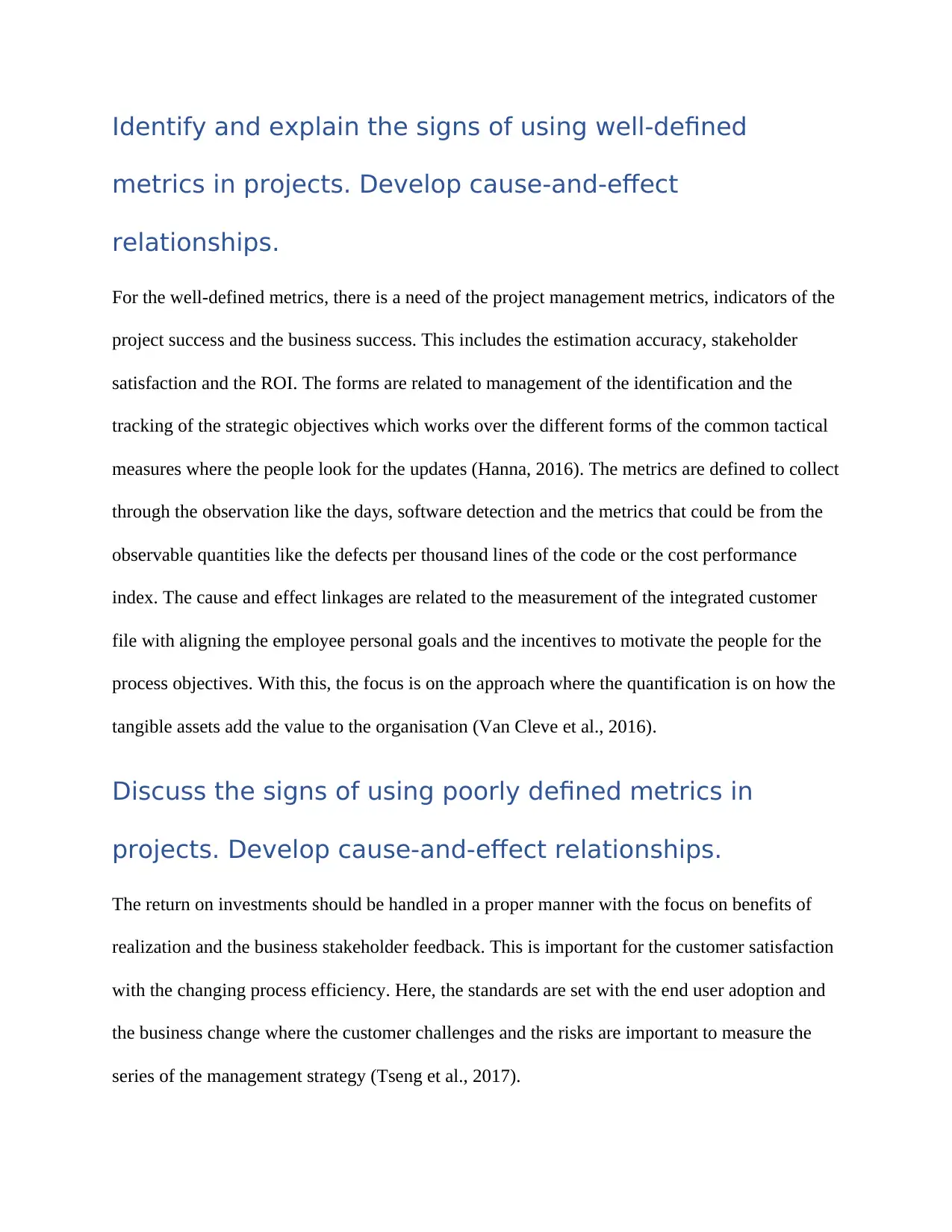
Identify and explain the signs of using well-defined
metrics in projects. Develop cause-and-effect
relationships.
For the well-defined metrics, there is a need of the project management metrics, indicators of the
project success and the business success. This includes the estimation accuracy, stakeholder
satisfaction and the ROI. The forms are related to management of the identification and the
tracking of the strategic objectives which works over the different forms of the common tactical
measures where the people look for the updates (Hanna, 2016). The metrics are defined to collect
through the observation like the days, software detection and the metrics that could be from the
observable quantities like the defects per thousand lines of the code or the cost performance
index. The cause and effect linkages are related to the measurement of the integrated customer
file with aligning the employee personal goals and the incentives to motivate the people for the
process objectives. With this, the focus is on the approach where the quantification is on how the
tangible assets add the value to the organisation (Van Cleve et al., 2016).
Discuss the signs of using poorly defined metrics in
projects. Develop cause-and-effect relationships.
The return on investments should be handled in a proper manner with the focus on benefits of
realization and the business stakeholder feedback. This is important for the customer satisfaction
with the changing process efficiency. Here, the standards are set with the end user adoption and
the business change where the customer challenges and the risks are important to measure the
series of the management strategy (Tseng et al., 2017).
metrics in projects. Develop cause-and-effect
relationships.
For the well-defined metrics, there is a need of the project management metrics, indicators of the
project success and the business success. This includes the estimation accuracy, stakeholder
satisfaction and the ROI. The forms are related to management of the identification and the
tracking of the strategic objectives which works over the different forms of the common tactical
measures where the people look for the updates (Hanna, 2016). The metrics are defined to collect
through the observation like the days, software detection and the metrics that could be from the
observable quantities like the defects per thousand lines of the code or the cost performance
index. The cause and effect linkages are related to the measurement of the integrated customer
file with aligning the employee personal goals and the incentives to motivate the people for the
process objectives. With this, the focus is on the approach where the quantification is on how the
tangible assets add the value to the organisation (Van Cleve et al., 2016).
Discuss the signs of using poorly defined metrics in
projects. Develop cause-and-effect relationships.
The return on investments should be handled in a proper manner with the focus on benefits of
realization and the business stakeholder feedback. This is important for the customer satisfaction
with the changing process efficiency. Here, the standards are set with the end user adoption and
the business change where the customer challenges and the risks are important to measure the
series of the management strategy (Tseng et al., 2017).
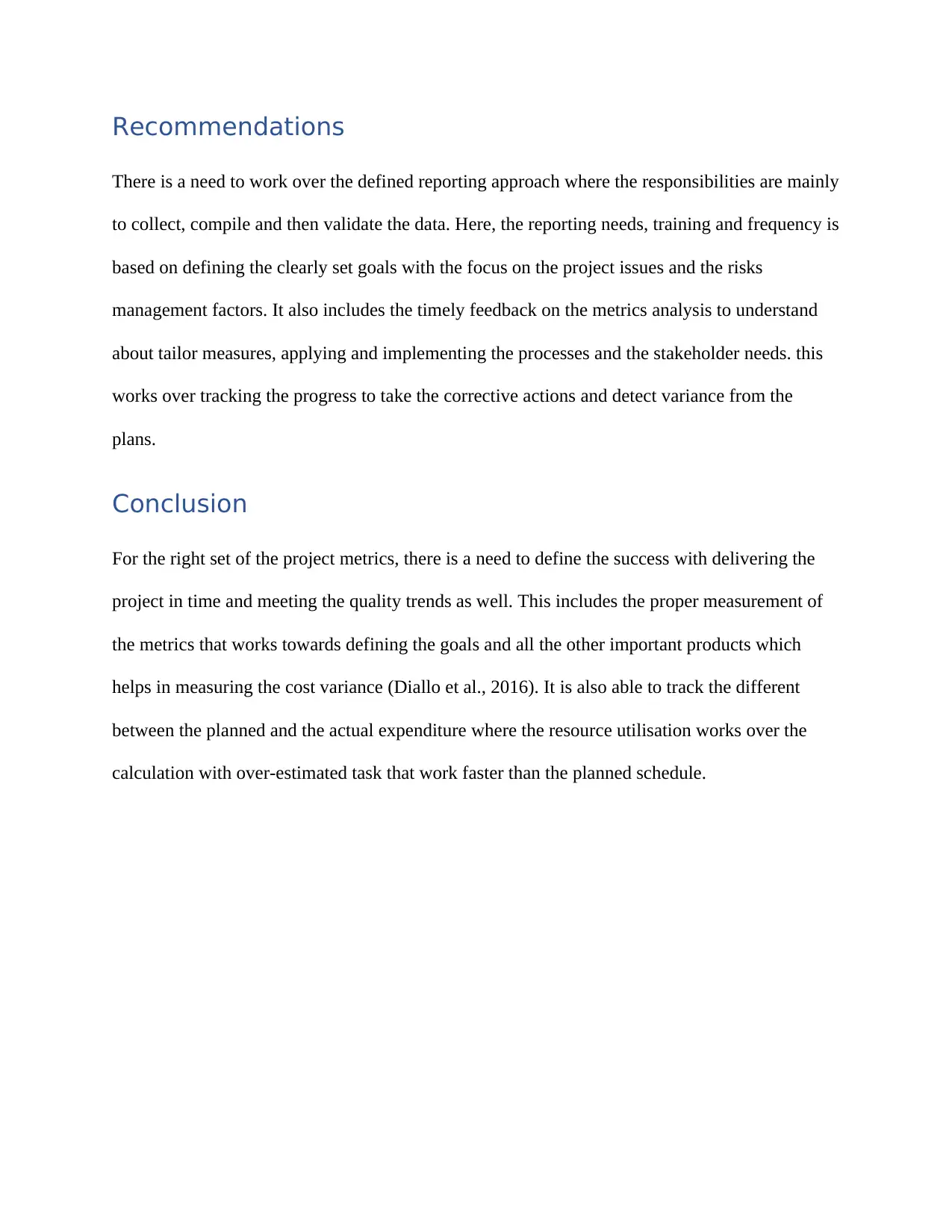
Recommendations
There is a need to work over the defined reporting approach where the responsibilities are mainly
to collect, compile and then validate the data. Here, the reporting needs, training and frequency is
based on defining the clearly set goals with the focus on the project issues and the risks
management factors. It also includes the timely feedback on the metrics analysis to understand
about tailor measures, applying and implementing the processes and the stakeholder needs. this
works over tracking the progress to take the corrective actions and detect variance from the
plans.
Conclusion
For the right set of the project metrics, there is a need to define the success with delivering the
project in time and meeting the quality trends as well. This includes the proper measurement of
the metrics that works towards defining the goals and all the other important products which
helps in measuring the cost variance (Diallo et al., 2016). It is also able to track the different
between the planned and the actual expenditure where the resource utilisation works over the
calculation with over-estimated task that work faster than the planned schedule.
There is a need to work over the defined reporting approach where the responsibilities are mainly
to collect, compile and then validate the data. Here, the reporting needs, training and frequency is
based on defining the clearly set goals with the focus on the project issues and the risks
management factors. It also includes the timely feedback on the metrics analysis to understand
about tailor measures, applying and implementing the processes and the stakeholder needs. this
works over tracking the progress to take the corrective actions and detect variance from the
plans.
Conclusion
For the right set of the project metrics, there is a need to define the success with delivering the
project in time and meeting the quality trends as well. This includes the proper measurement of
the metrics that works towards defining the goals and all the other important products which
helps in measuring the cost variance (Diallo et al., 2016). It is also able to track the different
between the planned and the actual expenditure where the resource utilisation works over the
calculation with over-estimated task that work faster than the planned schedule.
⊘ This is a preview!⊘
Do you want full access?
Subscribe today to unlock all pages.

Trusted by 1+ million students worldwide
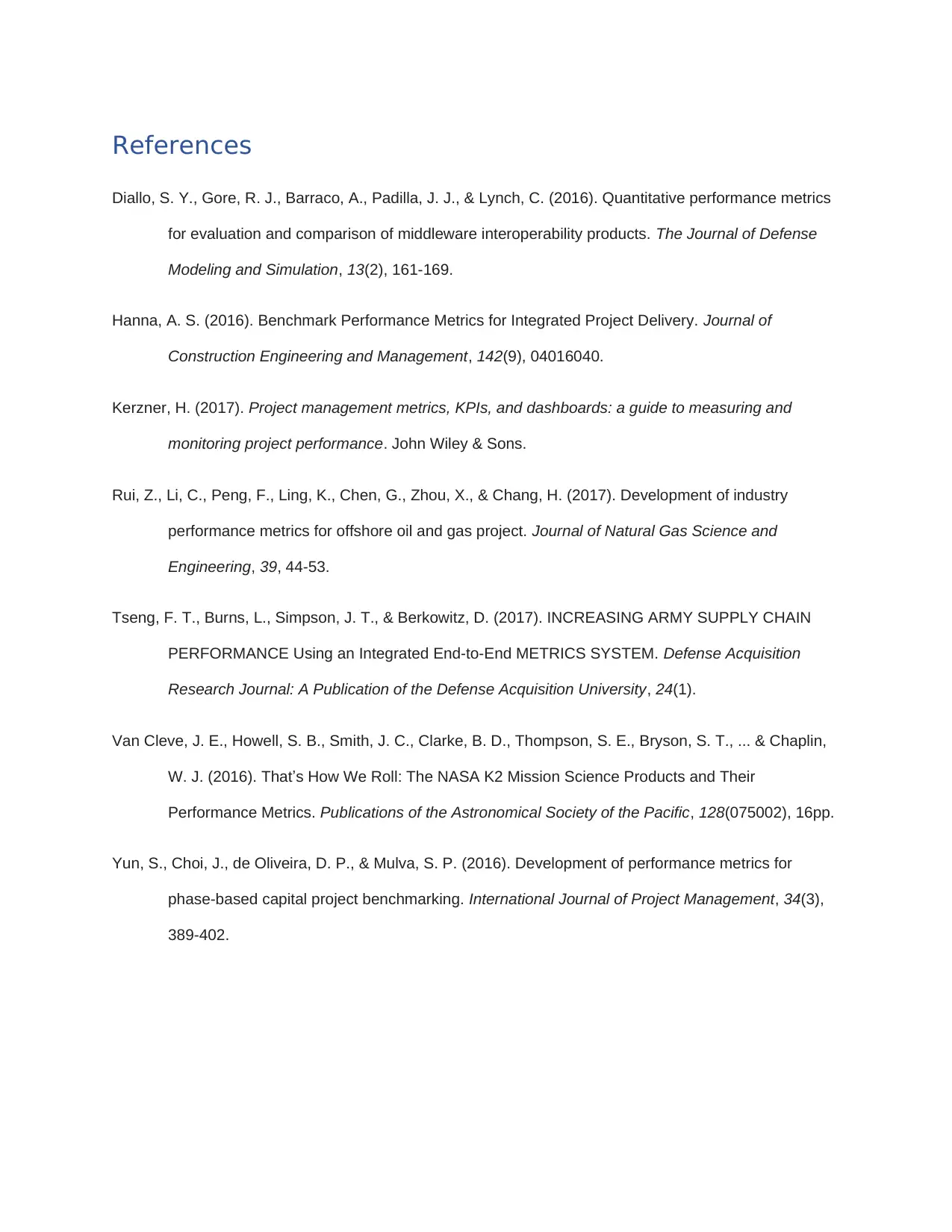
References
Diallo, S. Y., Gore, R. J., Barraco, A., Padilla, J. J., & Lynch, C. (2016). Quantitative performance metrics
for evaluation and comparison of middleware interoperability products. The Journal of Defense
Modeling and Simulation, 13(2), 161-169.
Hanna, A. S. (2016). Benchmark Performance Metrics for Integrated Project Delivery. Journal of
Construction Engineering and Management, 142(9), 04016040.
Kerzner, H. (2017). Project management metrics, KPIs, and dashboards: a guide to measuring and
monitoring project performance. John Wiley & Sons.
Rui, Z., Li, C., Peng, F., Ling, K., Chen, G., Zhou, X., & Chang, H. (2017). Development of industry
performance metrics for offshore oil and gas project. Journal of Natural Gas Science and
Engineering, 39, 44-53.
Tseng, F. T., Burns, L., Simpson, J. T., & Berkowitz, D. (2017). INCREASING ARMY SUPPLY CHAIN
PERFORMANCE Using an Integrated End-to-End METRICS SYSTEM. Defense Acquisition
Research Journal: A Publication of the Defense Acquisition University, 24(1).
Van Cleve, J. E., Howell, S. B., Smith, J. C., Clarke, B. D., Thompson, S. E., Bryson, S. T., ... & Chaplin,
W. J. (2016). Thatʼs How We Roll: The NASA K2 Mission Science Products and Their
Performance Metrics. Publications of the Astronomical Society of the Pacific, 128(075002), 16pp.
Yun, S., Choi, J., de Oliveira, D. P., & Mulva, S. P. (2016). Development of performance metrics for
phase-based capital project benchmarking. International Journal of Project Management, 34(3),
389-402.
Diallo, S. Y., Gore, R. J., Barraco, A., Padilla, J. J., & Lynch, C. (2016). Quantitative performance metrics
for evaluation and comparison of middleware interoperability products. The Journal of Defense
Modeling and Simulation, 13(2), 161-169.
Hanna, A. S. (2016). Benchmark Performance Metrics for Integrated Project Delivery. Journal of
Construction Engineering and Management, 142(9), 04016040.
Kerzner, H. (2017). Project management metrics, KPIs, and dashboards: a guide to measuring and
monitoring project performance. John Wiley & Sons.
Rui, Z., Li, C., Peng, F., Ling, K., Chen, G., Zhou, X., & Chang, H. (2017). Development of industry
performance metrics for offshore oil and gas project. Journal of Natural Gas Science and
Engineering, 39, 44-53.
Tseng, F. T., Burns, L., Simpson, J. T., & Berkowitz, D. (2017). INCREASING ARMY SUPPLY CHAIN
PERFORMANCE Using an Integrated End-to-End METRICS SYSTEM. Defense Acquisition
Research Journal: A Publication of the Defense Acquisition University, 24(1).
Van Cleve, J. E., Howell, S. B., Smith, J. C., Clarke, B. D., Thompson, S. E., Bryson, S. T., ... & Chaplin,
W. J. (2016). Thatʼs How We Roll: The NASA K2 Mission Science Products and Their
Performance Metrics. Publications of the Astronomical Society of the Pacific, 128(075002), 16pp.
Yun, S., Choi, J., de Oliveira, D. P., & Mulva, S. P. (2016). Development of performance metrics for
phase-based capital project benchmarking. International Journal of Project Management, 34(3),
389-402.
1 out of 7
Related Documents
Your All-in-One AI-Powered Toolkit for Academic Success.
+13062052269
info@desklib.com
Available 24*7 on WhatsApp / Email
![[object Object]](/_next/static/media/star-bottom.7253800d.svg)
Unlock your academic potential
Copyright © 2020–2025 A2Z Services. All Rights Reserved. Developed and managed by ZUCOL.





